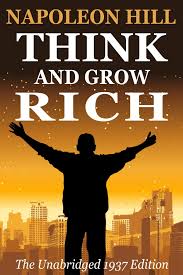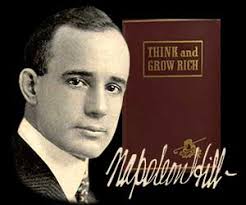You can imagine having a personal roadmap to success – one that distills the habits, thoughts, and principles followed by the world’s most successful individuals. Think and Grow Rich by Napoleon Hill is exactly that: a blueprint for achieving not only financial success, but also success in any area of life. Written in 1937, this book has stood the test of time, inspiring millions of people around the globe to break free from limitations and turn their dreams into reality.
“The starting point of all achievement is DESIRE. Keep this constantly in mind. Weak desire brings weak results, just as a small fire makes a small amount of heat.”
― Napoleon Hill, Think and Grow Rich

What makes this book special is that it wasn’t based on theory or abstract concepts; it was born out of years of studying real-life giants like Andrew Carnegie, Thomas Edison, Henry Ford, and other titans of industry. Hill analyzed their strategies, their mindsets, and their principles to develop a 13-step philosophy that anyone can follow to achieve their own version of success.
The power of Think and Grow Rich lies in the idea that success is not just about luck, talent, or hard work – it’s about the way you think. Hill teaches us that if you can control your thoughts and channel them with purpose, there’s no limit to what you can achieve.
At the core of Hill’s philosophy is the concept of desire – a burning, unwavering desire to achieve your goals. According to Hill, success begins in the mind. If you don’t have a clear vision of what you want and the intense drive to achieve it, you’ll remain stuck in mediocrity. He stresses the importance of having a definite goal and visualizing it with such intensity that it becomes a consuming obsession.

Take the story of Edwin C. Barnes, one of the key examples Hill gives. Barnes had a burning desire to work with Thomas Edison, not as a mere employee, but as his business partner. Despite having no money, no connections, and no qualifications, Barnes held onto that vision relentlessly. He made his way to Edison’s office and, over time, became exactly what he had envisioned—a partner. This real-life story illustrates Hill’s message: When your desire is strong enough, you’ll find a way.
Another cornerstone of Hill’s teachings is the power of faith. He’s not talking about blind faith or religious belief, but faith in your own abilities and the certainty that you can succeed. This kind of faith fuels your actions and attracts the right circumstances, opportunities, and people into your life. It’s a key ingredient in turning a dream into reality. Hill repeatedly reminds us that doubt kills more dreams than failure ever will, and that belief in yourself is essential.
Hill’s emphasis on autosuggestion is also groundbreaking. He teaches that by repeatedly affirming your goals, visualizing them, and feeding your mind with positive thoughts, you can influence your subconscious mind. Once your subconscious is aligned with your conscious desires, it works tirelessly in the background, guiding your actions and decisions toward achieving your goals. Athletes, like Muhammad Ali, who famously declared “I am the greatest” long before he was, are modern examples of Hill’s principles in action.

Application to Real Life
Look at today’s most successful entrepreneurs—people like Oprah Winfrey or Richard Branson. These individuals didn’t just stumble upon success. They visualized what they wanted, believed unwaveringly in their potential, and maintained laser-like focus on their goals. This is exactly what Hill advises.
Winfrey, for example, has spoken about how she used the power of intention to create her media empire. Her belief in herself and her vision drove her to break through seemingly insurmountable obstacles, a lesson straight out of Hill’s book.
“When defeat comes, accept it as a signal that your plans are not sound, rebuild those plans, and set sail once more toward your coveted goal.”
― Napoleon Hill, Think and Grow Rich
Another example is Elon Musk, whose audacious goals—whether it’s colonizing Mars or building electric cars—are underpinned by the same principles Hill discusses. Musk didn’t achieve his success through conventional thinking; it was his ability to dream big, backed by relentless belief, that set him apart.
Strengths of the Book
One of the greatest strengths of Think and Grow Rich is its timeless wisdom. Hill’s principles transcend time, industry, and circumstance. They’ve worked for people in the 1930s, and they continue to work in today’s high-tech, fast-paced world. The book’s lessons on perseverance, imagination, and faith are as relevant now as they were when Hill first wrote them.
Another key strength is the simplicity of the concepts. Hill doesn’t overwhelm you with complex theories; instead, he presents clear, actionable steps that anyone can follow. Whether it’s the importance of having a mastermind group—a circle of like-minded individuals who push you forward—or the practice of using autosuggestion to influence your subconscious mind, Hill lays out a concrete plan for success.
“Before success comes in any man’s life, he is sure to meet with much temporary defeat, and, perhaps, some failure. When defeat overtakes a man, the easiest and most logical thing to do is to quit. That is exactly what the majority of men do. More than five hundred of the most successful men this country has ever known told the author their greatest success came just one step beyond the point at which defeat had overtaken them.”
― Napoleon Hill, Think and Grow Rich

Hill’s ability to use real-life examples is also compelling. Whether it’s Henry Ford’s rise from poverty to becoming a titan of industry, or Edison’s refusal to accept failure despite 10,000 unsuccessful attempts at inventing the light bulb, the stories in the book inspire belief that greatness is possible, no matter where you start.
Potential Drawbacks
One potential drawback is that some of Hill’s language and examples feel dated, given the book was written in the 1930s. Some readers might find the style a bit formal or old-fashioned. Also, a few of the ideas, like the metaphysical discussions around the “infinite intelligence,” might feel abstract or hard to grasp for practical-minded readers.
However, these minor issues don’t detract from the core message: that your thoughts have immense power to shape your destiny.
“A quitter never wins-and-a winner never quits.”
― Napoleon Hill, Think and Grow Rich
Conclusion
Think and Grow Rich is not just a financial manual—it’s a life philosophy. It’s about transforming your mindset, developing a burning desire for success, and aligning your thoughts and actions with your goals. Hill teaches that true wealth and success begin in the mind, and that by mastering your thoughts, you can unlock a limitless future.
This book is for anyone who wants to go beyond average, break through barriers, and achieve extraordinary success. It’s a reminder that the power to change your life lies within you, and that by applying the right principles, you can achieve anything you set your mind to. Whether you’re an entrepreneur, an artist, or someone looking to improve any area of your life, Think and Grow Rich is your guide to turning dreams into reality.
As Hill puts it, “Whatever the mind can conceive and believe, it can achieve.” Are you ready to take control of your thoughts and grow rich in every sense of the word? Now is the time to start.
Contributed by Agolo Eugene Uzorka, CEO/ Lead Consultant, Eugene + George Consulting Limited














I’m extremely impressed along with your writing skills as neatly as with the layout to your weblog. Is this a paid theme or did you customize it your self? Anyway stay up the nice high quality writing, it is uncommon to see a nice weblog like this one nowadays!